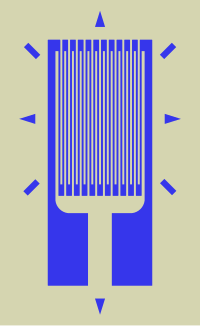
Photo from wikipedia
Monolayer blue phosphorene (BlueP) systems were investigated under biaxial strain range from −10% to +10%. All these systems exhibit excellent stability, accompanying changes in the electronic and optical properties. BlueP… Click to show full abstract
Monolayer blue phosphorene (BlueP) systems were investigated under biaxial strain range from −10% to +10%. All these systems exhibit excellent stability, accompanying changes in the electronic and optical properties. BlueP becomes metallic at −10% strain and transforms into a direct semiconductor at 10% strain while maintaining indirect semiconductor behaviors at −8% to +8% strain. The bandgap of BlueP decreases linearly with strain, and tensile strain exhibits a more moderate bandgap modulation than compressive strain. The real part of the dielectric function of BlueP is enhanced under compressive strain, while the optical absorption in the visible and the infrared light regions increases significantly under tensile strain. The maximum absorption coefficient of 0.52 ×105/cm occurs at 530 nm with the 10% strain. Our analysis indicates that the semiconductor–metal transition and the indirect–direct bandgap transition are the competition results of the energy states near the Fermi level under a massive strain. The potent compressive strain leads the p y orbitals of the conduction band to move downward and pass through the Fermi level at the K point. The robust tensile strain guides the energy states at the Γ point to approach the Fermi level and become the band edges. Our results suggest that the energy storage capacity of BlueP can be significantly improved by compressive strain, while the visible light photocatalytic performance is enhanced by tensile strains of less than 8%. Our works provide a reference for the practical applications of BlueP in photocatalyst, photovoltaic cells, and electronic devices.
Journal Title: Frontiers in Chemistry
Year Published: 2022
Link to full text (if available)
Share on Social Media: Sign Up to like & get
recommendations!